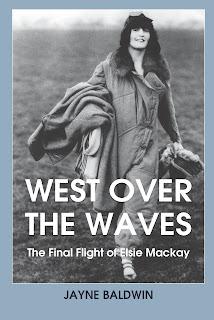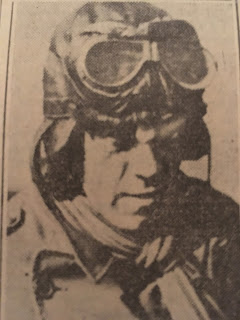The Final Flight of Elsie Mackay
Ten years ago I published a small pamphlet about the Atlantic attempt made by Elsie Mackay in March 1928. Spurred on by the interest in her story I continued my research resulting in the later publication of West Over the Waves, the Final Flight of Elsie Mackay by GC Books. Last year a new revised version of my book was published by 2QT Publishing. Join me as I blog about the count down to Elsie's attempt to become the first woman to fly the Atlantic.
In February 1928 a small aeroplane was flown to RAF Cranwell in Lincolnshire by Captain W G R Hinchliffe and his co pilot Elsie Mackay. It was very unusual for a civilian plane to be given permission to use this training school for the relatively new Royal Air Force but the pilots were not ordinary people. Captain Walter George Raymond Hinchliffe had earned his wings in the First World War and despite losing the sight of one eye in a terrible crash since then he had become one of the world's best pilots. Miss Mackay was the Honourable Elsie Mackay, the daughter of Lord Inchcape, chairman of the famous P & O shipping company and one of Britain's most important business business leaders. In her own right she had become widely admired as an example of the 'new woman' having not only become a respected pilot but also one of the first women to be involved in the design of ship's interiors.
Despite her achievements and her new career, Elsie held a secret ambition - to become the first woman to fly the Atlantic. Although Alcock and Brown had flown from the USA to Ireland in 1919 during the late Twenties a fever seemed to grip aviators on both sides of the ocean. Big money prizes were on offer encouraging those interested in this extremely dangerous challenge. Aviation was still in it's infancy, the planes were basic compared to what we're used to these days and the weather could not be predicted. The glamour and danger involved in flying meant that it attracted great interest from the public. The antics of aviators were frequently in the headlines, and publicity was usually being sought by the flyers to help promote their sponsors - plane and engine manufacturers, fuel and tyre companies. But Elsie didn't need sponsorship, she was a woman of great wealth and could afford to pay for all the costs involved, the purchase of the Stinson Detroiter plane and its transport back from the US, the services of mechanics and, most importantly, the employment of Ray Hinchliffe as her co pilot.
The Stinson had been transported to Brooklands in Surrey, near the family home of Captain Hinchliffe and his pregnant wife and young daughter. Here it had been adapted to the aviator's specifications in order to accommodate all the fuel that would be needed to fly the Atlantic. Numerous test flights had taken place with Elsie learning the new skills that would be needed for a successful crossing. The plane had also been named the Endeavour and the wings and struts painted in gold. As the Air Minister was a Mackay family friend, Elsie had been able to negotiate special permission to use the Lincolnshire RAF base but only for a limited period only and as the plane landed the clock had started ticking.
In February 1928 a small aeroplane was flown to RAF Cranwell in Lincolnshire by Captain W G R Hinchliffe and his co pilot Elsie Mackay. It was very unusual for a civilian plane to be given permission to use this training school for the relatively new Royal Air Force but the pilots were not ordinary people. Captain Walter George Raymond Hinchliffe had earned his wings in the First World War and despite losing the sight of one eye in a terrible crash since then he had become one of the world's best pilots. Miss Mackay was the Honourable Elsie Mackay, the daughter of Lord Inchcape, chairman of the famous P & O shipping company and one of Britain's most important business business leaders. In her own right she had become widely admired as an example of the 'new woman' having not only become a respected pilot but also one of the first women to be involved in the design of ship's interiors.
Despite her achievements and her new career, Elsie held a secret ambition - to become the first woman to fly the Atlantic. Although Alcock and Brown had flown from the USA to Ireland in 1919 during the late Twenties a fever seemed to grip aviators on both sides of the ocean. Big money prizes were on offer encouraging those interested in this extremely dangerous challenge. Aviation was still in it's infancy, the planes were basic compared to what we're used to these days and the weather could not be predicted. The glamour and danger involved in flying meant that it attracted great interest from the public. The antics of aviators were frequently in the headlines, and publicity was usually being sought by the flyers to help promote their sponsors - plane and engine manufacturers, fuel and tyre companies. But Elsie didn't need sponsorship, she was a woman of great wealth and could afford to pay for all the costs involved, the purchase of the Stinson Detroiter plane and its transport back from the US, the services of mechanics and, most importantly, the employment of Ray Hinchliffe as her co pilot.
The Stinson had been transported to Brooklands in Surrey, near the family home of Captain Hinchliffe and his pregnant wife and young daughter. Here it had been adapted to the aviator's specifications in order to accommodate all the fuel that would be needed to fly the Atlantic. Numerous test flights had taken place with Elsie learning the new skills that would be needed for a successful crossing. The plane had also been named the Endeavour and the wings and struts painted in gold. As the Air Minister was a Mackay family friend, Elsie had been able to negotiate special permission to use the Lincolnshire RAF base but only for a limited period only and as the plane landed the clock had started ticking.



Comments
Post a Comment